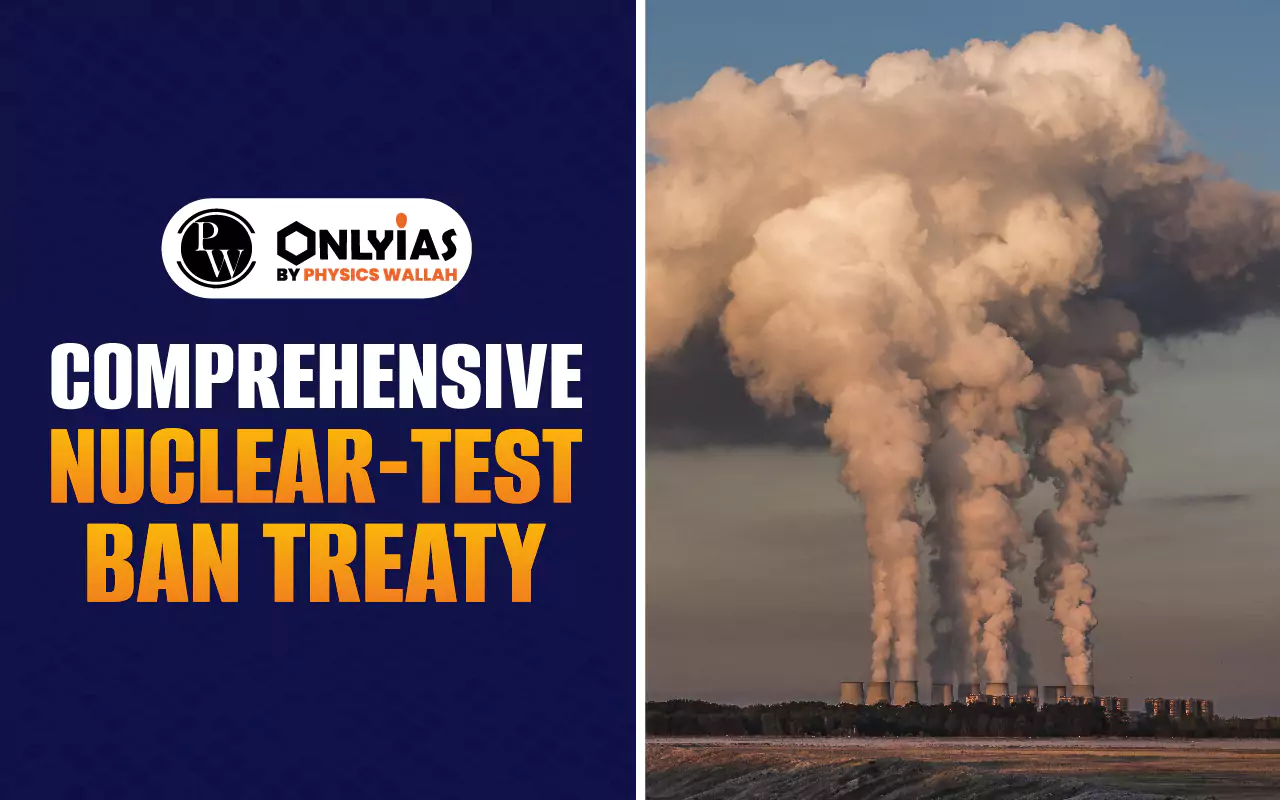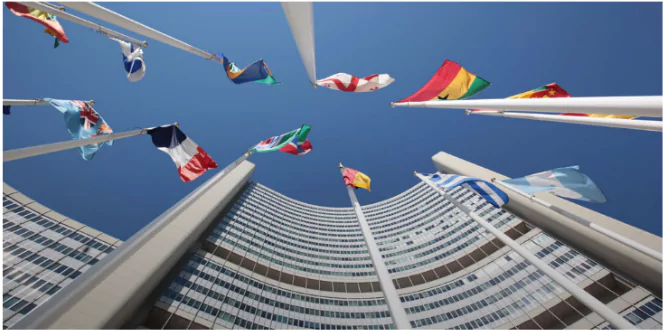Know about Comprehensive Nuclear-Test-Ban Treaty (CTBT) – its full form, history, objectives, verification system, signatories, and global significance. Learn why CTBT is key to disarmament and why it hasn't entered into force yet.

Comprehensive Nuclear-Test-Ban Treaty (CTBT) represents one of the most significant international efforts to halt nuclear weapon proliferation and promote disarmament. It prohibits all nuclear test explosions (whether for military or peaceful purposes) and is a critical step toward a world free of nuclear weapons. Though the Comprehensive Nuclear-Test-Ban Treaty 1996 has not formally entered into force, it has created a powerful global norm against nuclear testing and built an unparalleled verification regime.
The Comprehensive Nuclear-Test-Ban Treaty (CTBT) aims to eliminate nuclear explosions conducted for both military and civilian purposes. It prohibits all nuclear test explosions by everyone, everywhere: above ground, underwater, in the atmosphere, and underground. By halting qualitative improvements of nuclear weapons and the development of new types, it complements other arms control treaties like the Non-Proliferation Treaty (NPT).

Source: legal.un.org
Despite its non-enforcement, the CTBT has profoundly contributed to global peace and non-proliferation. It was opened for signature on 24 September 1996, but it awaits ratification by key Annex 2 States for entry into force.
| Comprehensive Nuclear-Test-Ban Treaty (CTBT) Overview | |
| Parameter | Details |
| Full Name | Comprehensive Nuclear-Test-Ban Treaty (CTBT) |
| Adopted by UN General Assembly | 10 September 1996 |
| Opened for Signature | 24 September 1996 |
| Treaty Objective | Ban all nuclear test explosions for military or civilian purposes |
| Primary Organization | Comprehensive Nuclear-Test-Ban Treaty Organisation (CTBTO) |
| Headquarters of CTBTO | Vienna, Austria |
| Verification Mechanism | International Monitoring System (IMS), On-Site Inspections, IDC |
| Number of Monitoring Stations (Planned) | 321 |
| Number of Radionuclide Labs (Planned) | 16 |
| Entry Into Force Requirement | Ratification by all 44 Annex 2 States |
| Ratifying Annex 2 States (as of now) | 36 out of 44 |
| Non-Ratifying Key Annex 2 States | China, Egypt, Iran, Israel, U.S., India, Pakistan, DPRK |
| Duration | Unlimited |
| Deposit Authority | United Nations Secretary-General |
| Related UPSC Topic | Disarmament, International Treaties, India’s Foreign Policy |
| Latest Review Conferences | Held in 2021 and 2023 |
| Availability of Treaty Text | Comprehensive Nuclear Test Ban Treaty PDF available on CTBTO.org |
| Associated Verification Protocol Parts | Part I: IMS, Part II: On-Site Inspection, Part III: Confidence-Building |
The idea of a test ban dates back to the Cold War, but it was not until 1994 that the Conference on Disarmament (CD) in Geneva began substantive negotiations. After more than two years of negotiations, a final draft was introduced in June 1996, but India objected due to concerns about the Treaty’s entry-into-force clause and the lack of commitment to complete nuclear disarmament.
As a result, the draft was presented to the UN General Assembly, which adopted the Comprehensive Nuclear-Test-Ban Treaty (CTBT) on 10 September 1996, opening it for signature later that month.
The Comprehensive Nuclear-Test-Ban Treaty comprises a preamble, 17 articles, two annexes, and a protocol with two further annexes.
| Structure and Key Provisions of the CTBT | |
| Component | Description |
| Article I | Prohibits all nuclear weapon test explosions or other nuclear explosions and obligates States Parties to prevent such actions under their jurisdiction. |
| Article II | Establishes the Comprehensive Nuclear-Test-Ban Treaty Organisation (CTBTO) in Vienna to oversee implementation and facilitate international cooperation. |
| Article III | Requires each State Party to adopt legal and administrative measures to fulfill Treaty obligations nationally. |
| Article IV | Details the global verification regime, including the International Monitoring System (IMS), International Data Centre (IDC), on-site inspections, and confidence-building measures. |
| Article V | Provides measures to address violations and ensure compliance with the Treaty. |
| Article VI | Outlines mechanisms for peaceful dispute settlement relating to Treaty interpretation or application. |
| Article VII | Specifies procedures for proposing and adopting amendments to the Treaty. |
| Article VIII | Calls for periodic review conferences to assess the effectiveness of the Treaty after its entry into force. |
| Article IX | Declares that the Treaty shall have unlimited duration. |
| Article X | Establishes the legal status of the Protocol and its annexes as integral parts of the Treaty. |
| Article XI | Addresses the process for signing the Treaty. |
| Article XII | Describes the process of ratification by States Parties. |
| Article XIII | Permits accession to the Treaty by States that did not sign it before it closed for signature. |
| Article XIV | Specifies conditions for entry into force, requiring ratification by all 44 Annex 2 States, 180 days after the last such ratification. |
| Article XV | Prohibits any reservations to the Treaty. |
| Article XVI | Designates the UN Secretary-General as the Depositary of the Treaty. |
| Article XVII | Confirms the authenticity of Treaty texts in Arabic, Chinese, English, French, Russian, and Spanish. |
| Annex I (Treaty) | Lists States by geographical region for election to the Executive Council. |
| Annex II (Treaty) | Lists the 44 States whose ratification is required for the Treaty’s entry into force. |
| Protocol Part I | Defines the role and technical specifics of the International Monitoring System (IMS) and International Data Centre (IDC). |
| Protocol Part II | Lays out procedures and conditions for on-site inspections to verify compliance. |
| Protocol Part III | Provides for confidence-building measures to enhance transparency and verification trust. |
| Annex I (Protocol) | Lists facilities comprising the IMS network. |
| Annex II (Protocol) | Defines parameters and criteria for event screening by the IDC. |
The Protocol further describes the operational aspects of these mechanisms, while Annex II lists the 44 States whose ratification is essential for the Treaty to enter into force.
The Preparatory Commission for the Comprehensive Nuclear-Test-Ban Treaty Organisation was established on 19 November 1996 to implement the CTBT provisionally until its entry into force. The CTBTO comprises:
Headquartered in Vienna, the CTBTO also partners with the United Nations under a relationship agreement (A/RES/54/280).

Source: CTBTO
The Treaty mandates an elaborate verification regime to ensure compliance:
This strong framework ensures that any nuclear test would be detected, making clandestine testing virtually impossible. Violations or disputes can be referred to the UN Security Council if deemed severe.
As of now, 185 countries have signed the Treaty, and 178 have ratified it. However, the CTBT has not entered into force due to eight Annex II States (China, Egypt, Iran, Israel, the United States, India, Pakistan, and North Korea) failing to ratify or sign it. This lack of ratification, particularly by nuclear-capable countries like the United States and Russia, remains a significant obstacle.
| Comprehensive Nuclear Test Ban Treaty Signatories | |
| Category | States |
| Total Signatories (as of now) | 187 Countries |
| Total Ratifications | 178 Countries |
| Annex 2 States (Total) | 44 States (whose ratification is mandatory for the Treaty’s entry into force) |
| Annex 2 States – Ratified | Algeria, Argentina, Australia, Austria, Bangladesh, Belgium, Brazil, Bulgaria, Canada, Chile, Colombia, D.R. Congo, Finland, France, Germany, Hungary, Indonesia, Italy, Japan, Mexico, Netherlands, Norway, Peru, Poland, South Korea, Romania, Slovakia, South Africa, Spain, Sweden, Switzerland, Türkiye, Ukraine, United Kingdom, Vietnam |
| Annex 2 States – Signed, Not Ratified | China, Egypt, Iran, Israel, United States |
| Annex 2 States – Not Signed | India, North Korea (DPRK), Pakistan |
| Non-Annex 2 States – Ratified | Examples: Afghanistan, Nepal, Nigeria, Ireland, Czech Republic, Kenya, etc. |
| Notable Non-Ratifying Nuclear States | United States, China, India, Pakistan, Israel, North Korea |
| Treaty Status | Pending Entry into Force due to lack of ratification from 8 Annex 2 States |
| Official CTBT Depositary | United Nations Secretary-General |
The Comprehensive Nuclear-Test-Ban Treaty (CTBT) is deeply integrated into broader nuclear disarmament frameworks such as the Nuclear Non-Proliferation Treaty (NPT) and the Fissile Material Cut-Off Treaty (FMCT). It complements these instruments by preventing the development of new and more advanced nuclear weapons, thereby freezing existing arsenals.
The Comprehensive Nuclear Test Ban Treaty UPSC topic is highly relevant to civil services aspirants, especially under international relations and disarmament themes. It also frequently features in international affairs discussions and geopolitics sections of the UPSC syllabus.
While Russia has ratified the CTBT, recent geopolitical developments and tensions with the West have raised questions about its continued commitment. In 2023, Russia hinted at possibly withdrawing from the Treaty in response to U.S. non-ratification and strategic instability. However, as of now, Russia remains a CTBT member, and its verification stations continue to function.
Despite its near-universal acceptance, the CTBT’s entry into force remains blocked by a few holdout states. This delay has strategic implications:
Conferences on Facilitating the Entry into Force, held every two years (most recently in 2023), attempt to address these challenges through political and diplomatic engagement. Furthermore, CTBT Ministerial Meetings are held on the sidelines of the UN General Assembly to renew high-level commitment.
On 29 May 2018, the UN launched “Securing our Common Future: An Agenda for Disarmament”, supporting the CTBT’s significance. Ministerial Meetings are regularly held during UN General Assembly sessions to accelerate the Treaty’s enforcement.
Held since 1999, these are periodic meetings aimed at urging pending states to complete ratification. The latest conference was held in 2023.
The Comprehensive Nuclear-Test-Ban Treaty (CTBT) is more than just a legal instrument—it represents a global moral and strategic consensus. Even in the absence of formal entry into force, it has had an undeniable deterrent effect, as no major nuclear test has been conducted by signatories since its adoption.
In today’s context of renewed geopolitical tensions and discussions of nuclear modernisation, the CTBT remains an essential buffer against nuclear escalation.
The Comprehensive Nuclear-Test-Ban Treaty (CTBT), though not yet in force, plays a foundational role in promoting global nuclear disarmament and non-proliferation. Its universal ratification remains a pressing international priority. The work of the Comprehensive Nuclear-Test-Ban Treaty Organization (CTBTO) in laying down a robust verification infrastructure is crucial. As global consensus builds, it is imperative for the remaining states to ratify and bring into force the Treaty, solidifying a world free from nuclear test explosions.
Ready to boost your UPSC 2025 preparation? Join PW’s UPSC online courses today!
The Comprehensive Nuclear Test Ban Treaty Organization (CTBTO) ensures implementation and verification of the Treaty through monitoring and inspections.
The Comprehensive Nuclear Test Ban Treaty UPSC topic is crucial for understanding global disarmament, non-proliferation efforts, and international treaties.
The Comprehensive Nuclear-Test-Ban Treaty (CTBT) obligates members to ban all nuclear test explosions and cooperate with verification measures.
Comprehensive Nuclear Test Ban Treaty members include over 180 signatories, though entry into force requires ratification by 44 Annex-2 States.
Yes, the Comprehensive Nuclear Test Ban Treaty PDF is available on the official CTBTO website and other disarmament documentation platforms.
Comprehensive Nuclear Test Ban Treaty Russia ratified the treaty but has shown concerns over U.S. non-ratification, affecting its long-term commitment.

<div class="new-fform">
</div>